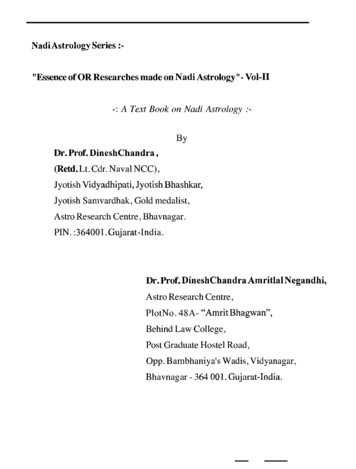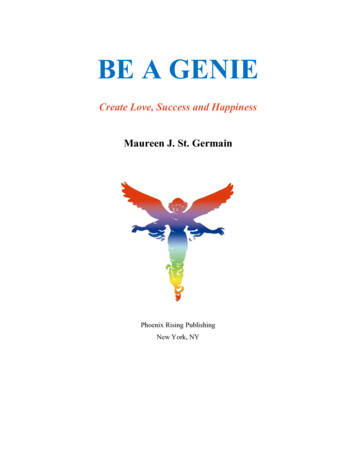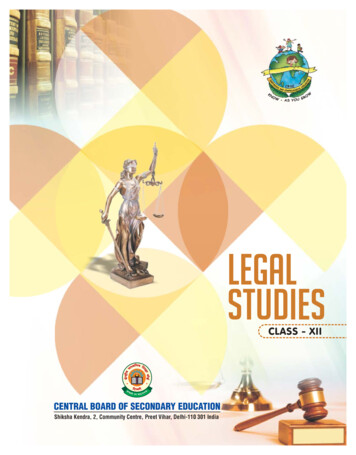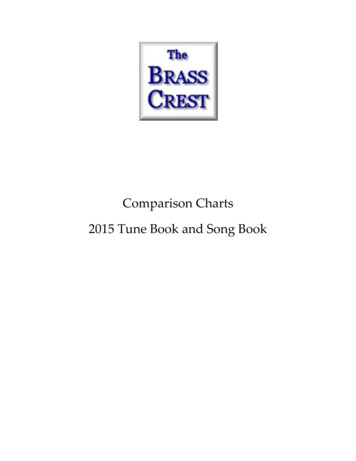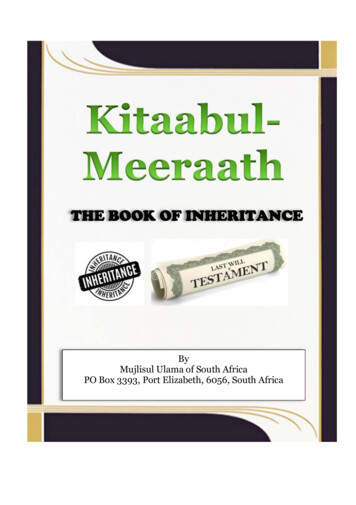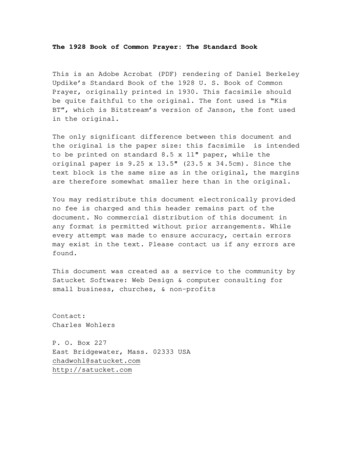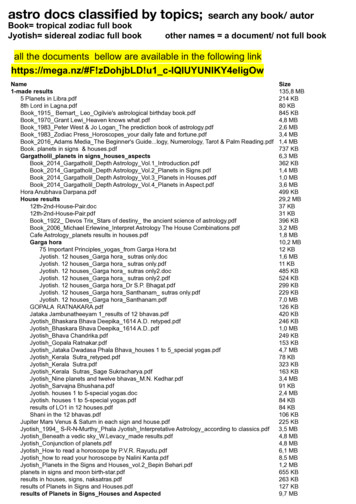
Transcription
TEXT FLY WITHINTHE BOOK ONLY
W m U3OU 1 60565 m
OUP433 tf.7 15,000OSMANIA UNIVERSITY LIBRARYGallNo.Author5*- Si-AccessionNo.9. a35 4-*
VEDIC CHRONOLOGYANDVEDANGA JYOTI8HA.[Containing also Chaldean and Indian Vedas andother miscellaneous essays.]BYLOKAMANYABAL GANGADHAR TILAK,B. A., LL. B,Author of the " Orion " or " Researchesinto the Antiquityof theVedas ",TheArctic"tcGitd-fiahasyaHomeSec.in the Vedas&c.PublishersMessrs TILAK BROS.Gaikwar Wada,POONA CITY-(All righu rearved by the1925."t
Printed by Mr. A. A. Moratnkar at his Shri Lax mi -Thakurdwar, Bombay,andPublished by Messrs R B and S. B. Tilak,Gaikwar Wada, Poona City.NarayanPress, 364,
CONTENTS.PAGE.1Vedic Chronology.ChapterIntroductionIIIThe Vedic Calendar2 Synopsis of the wholeChapters I to IX3A4The5ANote onij Tf *TT Book27&f (Appendix)Vedftnga Jyotisha (A Critical Note)Missing Versein1739.the Safikhya Kdrikas1056 Chaldean and Indian Vedas(a)43123Opinions of Dr. Say ce and Dr. Pinches.1457 Extracts from a Rough Note-Book:(a)(6)(c)Notes from Hellebrandt's Vedic MythologyMaterial for Revising the Arcticin the VedasOutlinesfor167(d) List of Chaldean Literature(e)Proposedtical(/}165the Orion al, Poli-&c.)The Golden Rule from the MaMbMrata.171173
SCHEME OP jjhBtthddhtthddhnpphbbhmy*1Tshahsh1kah9J8n
VEDIC CHRONOLOGY.PARTI.
VEDICCHRONOLOGYCHAPTERI.INTRODUCTION.Theancient Indian literatureisdivided intotwosections-Vedic and post-Vedic -and the chronologicalsequence of events in the latter can now be prettyaccurately determined by referring to the date ofBuddha, the invasion of Alexander the Great, the inscriptions of Ashoka, theShakaera,and a number of otherBut when wearchaeological facts recently discovered.go back to the Vedic literature, the oldest portions ofwhich admittedly depict the most ancient Aryanwhich any records have been left, we findno such landrmarks and in their absence the methodat first adopted by Western Sanskrit Scholars tocivilization of;ascertain the antiquity of the VedicCivilizationwasOn the face of it, thenecessarily vague and arbitrary.intofourdividedstrata or layersVedic literature isChhandas, Mantra, Brahmana, and Sutra and it isevident that each of these stages of development musthave lasted, at least for a few centuries before it passed;into the next.Taking, therefore, these layers for thebasis of his calculation,and assuming, at the lowest, 200years for each stage of development, Prof. MaxMuller,
2VEDIC CHRONOLOGY.HISTORY OF ANCIENT SANSKRIT LITERATURE,roughly fixed the age of Vedic civilization at 800inhisyears before Buddha, or at 1200 B. C. The moderationhere exhibited, was no doubt unobjectionable, ded with facts; and many other Vedic Scholarseven then considered this estimate as too low, andassigning 400 instead of 200 years for each successivecarried back the antiquitystage of development,of the Vedic culture to 2400 B. C. This was the generalopinion about the antiquity of the Vedic civilizationbefore the publication of my Orion and Dr. Jacobi'sessay "on the age of the Rigveda," in 1893, in both ofwhich the antiquity is carried back to about 4500 B. C.''on the strength of astronomical statements containedin the Vedic literature.Indian astronomy was one of the first subjects whichattracted the attention of Western Scholars after theexistence of Sanskrit literaturein the last quarter of thebecame known to themThere are a18th century.number of learned and critical articlesVolumes of Asiatic Researches by Sir W.brooke, Devies and other scholars on theimportant features of Indian Astronomy,intheJones,firstCole-speciale. g,andthe lunarzodiac and its antiquity, the Indian and the Arabicdivisions of zodiac, the precession of equinoxes, etc, etc.;andso far aswe know,thereishardly anything subsequently published, which surpasses these dissertationseither in the breadth of view or the soundness of judg*
INTRODUCTION.3exhibited therein. Even the Ved&nga Jyotisha,that small tract on Astronomy appended to the Ved&s,and which is the oldest astronomical work in Sanskrit,mentnotescape their attention ; and, though manyverses in it were then obscure, yet it was clearly seendidthat the position of solstices mentioned therein carriedus back, roughly speaking to about noo or 1400 B. C.But all the works, examined by these scholars arepost-Vedic, and help uslittle in ascertaining the antiThe Vedanga Jyotisha, isCivilization.ofVedicquitycertainly the oldest astronomical work now extant ; butnowthatthatitithas been fully deciphered one can easily seefirst work of its kind.It mustcannot be thehave been preceded by others of its kind but as thesenow available, we must search the Vedic books;are notthemselves for any astronomical data that enable us toascertain the age of Vedic literature. This was notdone till some years later as the attention of earlyscholarswas engrossedwhich werein discussing certain side issuesraised at the time.The French astronomerBailey, inhis treatise onIndian and Oriental astronomy, published in 1786, hadassigned a very high antiquity to the Indian Science ;anditwasto refute this view that Bentley published his"Historical view of Hindu Astronomy" in 1823. Bentleyendeavoured to ascertain the age of the Indian astro*nomical works solely by comparing the astronomicalstatements culatedastronomical
VEDIC CHRONOLOGY.4tablesand assigningto the said astronomicaltreatisesuch time as when the difference between the two wasthe smallest possible and by a reckless use of this;method he wasled to the prepostrousconclusion thatof the ancient astronomical Siddh&ntas, were inreality composed or fabricated, as Bentley thinks, in themanytimes of Akabar the great, in order to impose upon theemperor a false notion of their importance and antiquity.Hedidnotstophere,butattackedSirW.Jones, Colebrooke and other scholars for mainThis drew forth a sharptaining the opposite view.whofromColebrookeshowed how Bentclearlyreplymethod, used exclusively by itself, was utterlyAs Bentley's view is now generally rejectedunreliable.ley'sbyallscholars,it isunnecessary to go further into theby him. In spite ofdetails of the position maintainedwork however contains some ingenioussuggestions which we shall notice later on. It isits faults, hisenough to state here that side by side with this controversy, there was also raised and discussed anotherimportant qu estion viz.-whether the Indian astronomicalmethods, described in these post-Vedic works wereborrowed from the Greeks wholesale or whether theIndian astronomers, who had already a science of theirown, improved it by such hints received from Alexandria, as two civilised nations, when they come incontact, are generally glad to receivefrom each otherin the interest of scientific progress.Colebrooke heldthe latter view;and Rev. Burgen, who translated the
INTRODUCTION.5was a missionary at Ahmedof the same opinion. ButisourPresidency,magarwhoeditedand published the translaProf.Whitney,tion with notes under the auspecies of the AmericanSfirya Siddh&nta while heinOriental Society in 1860, has not a word to say infavour of the Indian Astronomers, whom he considersincapable of originating any scientific theory orany even tolerably accurate observations.thereforecomemakingHeto the conclusion that the Indianswholesale borrowers inthisTherespect.haswereprestigewhich Whitney enjoyed on account of his great learning and scholarship unfortunately contributed to render,sometime, his judgment acceptable, in preferenceBut it has been shown byto that of Colebrooke.forShankar BalkrishnaDiksit, a practicalIndian astrono-mer possessing a wider acquaintance with the whole ofthe Indian astronomical literature, in his importantwork on the " History of Indian Astronomy " publishedinMarathi in 1896, that Whitney's viewresult of histo aprejudices,numbertheIndiansaidutmostsupport ofthefact,ers,butofSiddh&itas,that can be1903,overlooked bynoticedbythat initisopposedentirelyfacts disclosedinand that Colebrooke hassaid on the subject."InDiksit's rejoinder," Ancient Calendars andinthatastronomicalsimply theiswe mayWhitneyPlunkettfurther mentionandinhishisConstellations,follow,work on"publishedcontrast with the praise." bestowedby Garga on Yawanas - evidently Greeks -fortheir
VEDIC CHRONOLOGY.t proficiency in astrology, we find, the Greek writers of the first century of the Christian era, holding a very high*,opinion about Indian Astronomy;and thatin the life-of Apollonius of Tyana, his biographer represents himas learning many things from the Sages of India,,especially matters of astronomy.was borrowing on bothThis shows that thereand that Whitney's biastheancient Indian astronomers was entirelyagainstsidesunfounded.The wholeof the above discussionwas related andconfined only to the post-Vedic astronomical works.But the next question that arose necessitated aninquiry into the astronomical statements contained inWorks themselves. In 1840 and the follow-the Vedicing years,the well-known French astronomer,J.B.Biot, published a number of articles in the Journal desSavants (subsequently also published in the form of aseparate book in 1859), * n which he endeavoured toprove that the Indian system of Nakshatr s must havebeen borrowed from the Chinese, because in theplace the antiquity of the; Chinese system wasfirstfullyauthenticated by reliable ancient texts, going back to2357 B- C. when the vernal equinox was in Mao (i. e.Indian Krittikas), and secondly because from the pracastronomical point of view the stars in theticalChinese system of giwn (Nakshatr s) were mathematicthe purpose for which they wereused, viz., to observe meridian passage of equinoctialand solstitial points, as well as that of certain circumally best suited for
7INTRODUCTION.These stars, he maintained, were originallyto which 4 more corresponding to thenumber24two solstitial and two equinoctial points of the time werepoalr stars.inadded, in aboutnooB. C., thus increasing thetotalnumber of ico/ to 28. Most of these stars are thesame in the Chinese and the Indian system but theywere unsuited to measure the equal distances betweenthe successive daily positions of the moon, which isthe purpose for which they were used in India. Biot,;therefore,concludedmust belong to thattobe best suitedChinaat;somepurpose.thatplace,tothe priority of discoverywhere the systemthe usemadefoundisthereof, viz., toand that Indians must have borrowed the samelater dateTheand useditauthority, whichawkwardlytheirfornaturally belongedtothe opinion of so great an astronomer as Biot led someSanskrit scholars of the time to adopt his view, and wefind it accepted, though in a somewhat modified form,even by Whitney in his edition of the translation of"Surya Siddhanta published in 1860, Prof. AlfredWeber, however,clearlysaw the weakness ofBiot'sposition resting as it did, on the supposed antiquity ofthe Chinese texts ; and the so called convenience ofastronomicalobservationdiligence and learninghe,of the al statements contained in the various Vedicin 1860 and 1862 his two essays.on "Die Vedisohen Nachricten Von der Naxatra '*works, and published the Vedic accounts of the Nakshatr&s).Inthefirst
VEDIC CHRONOLOGY.8of these he showedhowthe supposed antiquity of theChinese texts was unwarranted by historical facts andin the second conclusively proved that the ancientexistence of the Indian System of Nakshatr&s, with thewas fully borne out by passagesVedic works of undoubted antiquity. This was thefirst time that the astronomical statements containedin the Vedic Works were collected and so completeKrittikas at their head,in;that only a few Vedic texts bearing onIfsince discovered.subject have beenis this collectionthesameWeber had gone further and arranged and co-ordinatedthe texts collected by him he could have easily perceived that the series with the Krittikas (Pleiades) atthe head was not the oldest ofitskind and that theVedic works expressly refer to a still older system ofNakshatras with Mrigshiras (Orion) at the head. Butit is not uncommon that a Collector of materials sometimes misses to grasp their true significance, as was thecase with the great Danish astronomer, Tycho, whosenumerous observations formed the basis of the laws ofplanetary motion subsequently discovered byhis successor.the capacity ofKepler,Weber had the same low opinion aboutHindus to make any, even the crudestwas held by Whitney ; andheestablishedthethoughpriority of the Indian systemof Nakshatras over the Chinese, he was, in consequence,celestial observations, asled to believe, on almost imaginary grounds, that neitherthe Indians, nor the Chinese, nor again the Arabs,whose system of Manazil (Nakshatras) resembles the
INTRODUCTION.9Indian and the Chinese in many points, were the originalbut that all of themof the system'discoverers;must have borroweditfrom someAsian, possibly Babylonian source.stillunknown WestProf.MaxMullertin his preface to the fourth volume of the first editionof the Rigveda, published in 1862, contested this viewand rejected it as groundless. But he was not qualifiedtomakewho wasfurther research in this matterso qualifiedwas prevented by;and Whitneyhisprejudicesfrom diving deeper into the question, though he clearly"The Lunarsaw, as observed by him in his essay onZodiac'"published in 1874 in the second series of hisOriental and linguistic Studies," that Weber's " theoryAvas no better than a suspicion, perhaps not even worthu of acharacter tofinding expression as such ", orcompel belief" and that there was no reason "toimpugn either the candour or the good sense of anyone who might refuse to be won over to a like belief."But if Weber's theory was thus admittedly a mere suspicion it was clearly an error of judgme
INTRODUCTION. 3 mentexhibited therein. Even theVed&nga Jyotisha, thatsmall tract onAstronomy appended totheVed&s, andwhich istheoldest astronomical workinSanskrit, did not escape their attention; and, though many verses initwerethenobscure, yetit wasclearly seen thattheposition ofsolstices mentioned therein carried usback, roughly speaking toabout nooor1400 B.C. Butall theworks,
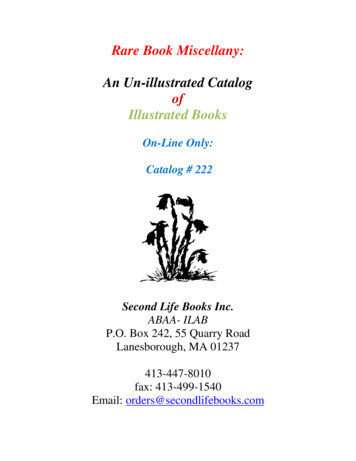

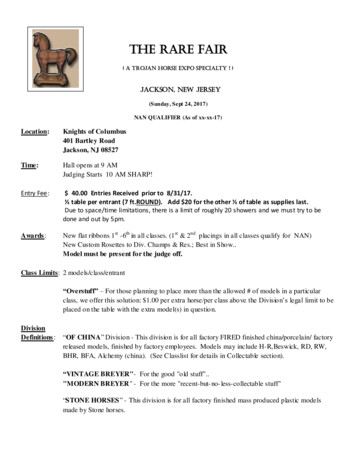
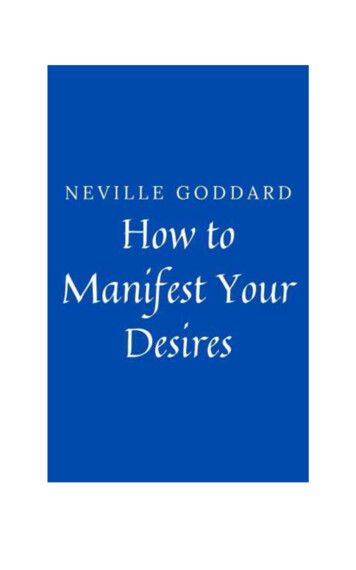
![English Text Book[1] - Weebly](/img/4/comprehension-and-communication-skills-in-english-engl101.jpg)
